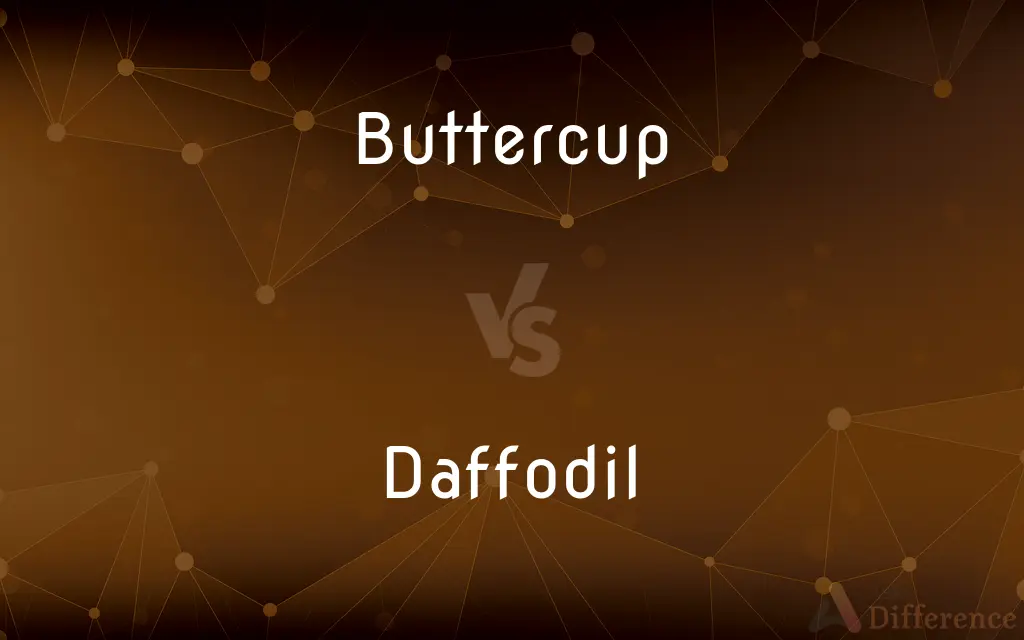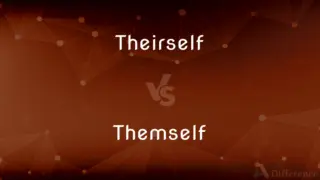Buttercup vs. Daffodil — What's the Difference?
By Fiza Rafique & Urooj Arif — Updated on March 13, 2024
Buttercups are small, yellow flowers known for their glossy appearance, part of the Ranunculaceae family; daffodils are spring-blooming perennials, part of the Amaryllidaceae family, recognized by their trumpet-shaped structure.

Difference Between Buttercup and Daffodil
Table of Contents
ADVERTISEMENT
Key Differences
Buttercups, belonging to the genus Ranunculus, are characterized by their bright yellow flowers and glossy petals, which create a reflective surface that enhances their color. They are found in a variety of habitats, including wetlands, grasslands, and woodlands. Daffodils, known scientifically as Narcissus, are distinct for their trumpet-shaped coronas surrounded by a ring of petals, usually in shades of yellow or white. Daffodils are widely cultivated for their aesthetic appeal and are symbolic of new beginnings and rebirth, often associated with spring.
The glossy appearance of buttercups is due to the layer structure of their petals, which efficiently reflects light, giving them a shiny look. This characteristic is not just for attractiveness; it also plays a role in attracting pollinators. Daffodils, on the other hand, have a structure that is particularly evolved to accommodate their pollinators, with the trumpet-shaped corona serving as a platform for insects.
Buttercups are often considered weeds in gardens and agricultural fields due to their rapid growth and ability to spread, potentially dominating spaces and affecting the growth of other plants. In contrast, daffodils are prized garden plants, cultivated for their beauty and their ability to herald spring. They are also less invasive and generally coexist well with other plants in a garden setting.
Both buttercups and daffodils contain toxic compounds; buttercups contain ranunculin, which can cause irritation and blistering upon contact with skin and is toxic if ingested. Daffodils contain lycorine and other compounds that can cause nausea, vomiting, and other symptoms if ingested. However, daffodils are often more closely associated with cases of accidental poisoning due to their bulbs being mistaken for edible bulbs, such as onions.
Despite these differences, both buttercups and daffodils have been celebrated in literature and folklore. Buttercups are often associated with childhood and innocence, while daffodils have been immortalized in poetry, most famously by William Wordsworth, reflecting their deeper cultural significance and enduring appeal.
ADVERTISEMENT
Comparison Chart
Family
Ranunculaceae
Amaryllidaceae
Appearance
Glossy, yellow petals
Trumpet-shaped structure, yellow/white
Habitat
Wetlands, grasslands, woodlands
Widely cultivated, associated with spring
Pollination
Reflective petals attract pollinators
Structure accommodates pollinators
Garden Role
Often considered weeds
Prized for aesthetic appeal
Toxicity
Contains ranunculin, can irritate skin
Contains lycorine, toxic if ingested
Cultural Significance
Associated with childhood, innocence
Symbolic of new beginnings, featured in poetry
Compare with Definitions
Buttercup
Glossy Petals.
The buttercup's glossy petals shine brightly in the sun.
Daffodil
Spring Bloom.
Daffodils herald the arrival of spring with their vibrant blooms.
Buttercup
Cultural Association.
Buttercups are a symbol of childhood and playfulness.
Daffodil
Literary Symbol.
Daffodils have been immortalized in poetry as symbols of beauty and renewal.
Buttercup
Weed Status.
Buttercups can dominate garden spaces, outcompeting other plants.
Daffodil
Trumpet-Shaped Coronas.
The daffodil's distinctive trumpet shape is a beacon for early spring pollinators.
Buttercup
Toxicity.
Caution is advised when handling buttercups due to their skin-irritating sap.
Daffodil
Toxicity Awareness.
Mistaking daffodil bulbs for onions can lead to accidental poisoning.
Buttercup
Widespread Habitat.
Buttercups flourish in the damp meadows of the countryside.
Daffodil
Garden Favorite.
Daffodils are a beloved addition to any spring garden, celebrated for their beauty.
Buttercup
Any of numerous herbs of the genus Ranunculus, native chiefly to temperate and cold regions and having acrid juice, often toothed or lobed leaves, and usually yellow or white flowers with numerous pistils.
Daffodil
Any of various bulbous plants of the genus Narcissus, especially one of the many cultivated varieties of N. pseudonarcissus, having showy, usually yellow flowers with a trumpet-shaped central corona.
Buttercup
Any of many herbs, of the genus Ranunculus, having yellow flowers; the crowfoot.
Daffodil
The flower of any of these plants.
Buttercup
Any flower of the genus Narcissus; a daffodil.
Daffodil
A brilliant to vivid yellow.
Buttercup
Affectionate or ironic term of address.
Daffodil
A bulbous plant of the genus Narcissus, with yellow flowers and a trumpet shaped corona, especially Narcissus pseudonarcissus, the national flower of Wales.
Buttercup
A plant of the genus Ranunculus, or crowfoot, particularly Ranunculus bulbosus, with bright yellow flowers; - called also butterflower, golden cup, and kingcup. It is the cuckoobud of Shakespeare.
Daffodil
A brilliant yellow color, like that of a daffodil.
Buttercup
Any of various plants of the genus Ranunculus
Daffodil
Of a brilliant yellow color, like that of a daffodil.
Daffodil
A plant of the genus Asphodelus.
With damask roses and daffadillies set.
Strow me the ground with daffadowndillies,And cowslips, and kingcups, and loved lilies.
A college gownThat clad her like an April daffodilly.
And chance-sown daffodil.
Daffodil
Any of numerous varieties of Narcissus plants having showy often yellow flowers with a trumpet-shaped central crown
Common Curiosities
Why are daffodils associated with spring?
Daffodils are among the first flowers to bloom in spring, symbolizing rebirth and new beginnings.
What makes buttercups glossy?
Buttercups' petals have a special layer structure that reflects light, creating a glossy appearance.
Can daffodils be planted with other flowers?
Yes, daffodils can coexist well with other plants and are often planted in mixed flower beds or borders for early spring color.
Why are buttercups considered weeds?
Buttercups are often seen as weeds because they grow quickly, spread easily, and can outcompete other plants for resources.
Can buttercups be harmful?
Yes, buttercups contain toxins that can irritate the skin and are poisonous if ingested.
What differentiates daffodils from other spring flowers?
Daffodils are distinguished by their unique trumpet-shaped coronas and their strong association with spring and renewal.
What role do buttercups play in the ecosystem?
Despite being considered weeds, buttercups are part of the ecosystem, providing food for insects and contributing to biodiversity.
How should daffodil bulbs be handled to avoid poisoning?
Daffodil bulbs should be clearly labeled and stored separately from edible bulbs to prevent accidental ingestion.
Are buttercups and daffodils easy to grow?
Daffodils are generally easy to grow and are hardy in many climates. Buttercups can grow readily in the wild but may not be desirable in gardens due to their invasive nature.
What should be done if someone ingests part of a daffodil or buttercup?
If ingestion occurs, seek medical advice immediately. The toxic compounds in these plants can cause serious health issues.
Share Your Discovery

Previous Comparison
Specificity vs. Selectivity
Next Comparison
Theirself vs. ThemselfAuthor Spotlight
Written by
Fiza RafiqueFiza Rafique is a skilled content writer at AskDifference.com, where she meticulously refines and enhances written pieces. Drawing from her vast editorial expertise, Fiza ensures clarity, accuracy, and precision in every article. Passionate about language, she continually seeks to elevate the quality of content for readers worldwide.
Co-written by
Urooj ArifUrooj is a skilled content writer at Ask Difference, known for her exceptional ability to simplify complex topics into engaging and informative content. With a passion for research and a flair for clear, concise writing, she consistently delivers articles that resonate with our diverse audience.
















































